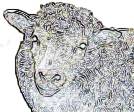 In the big scheme of animal evolution, according to Keys, a graduate student in Carroll's lab, the decoration of a butterfly's wing is a much more recent invention than the building of the wing itself: "Evolution, somewhere along the line, took this system and came up with a way to reuse it in an entirely new context while maintaining its original function."
In the big scheme of animal evolution, according to Keys, a graduate student in Carroll's lab, the decoration of a butterfly's wing is a much more recent invention than the building of the wing itself: "Evolution, somewhere along the line, took this system and came up with a way to reuse it in an entirely new context while maintaining its original function.""To our thinking, the reuse of genes makes innovation easier," said Carroll, a biologist whose work has helped resolve the role genes play in making such things as arms, legs and wings.
"Evolution," he said, "is working by integrating sets of things it already has. You're using a circuit over and over again."
How butterflies co-opt existing genetic programs to create eyespot patterns that help them fool predators, said Carroll, may in fact be a general mechanism animals use to create "luxury items -- teeth, antlers, shells, hair, coloration -- in the course of evolution."
These luxuries can be further tinkered with at the genetic level to create new variants, such as the enormous diversity of pattern and color in butterflies, or the array of antlers sported by different members of the deer family such as elk and moose.
"Once you make a new connection, it can independently evolve" through the interplay of development and genetic change, Carroll said. "Evolution can muck with that by changing things in the circuit."
"One of the amazing things about butterflies is that these genetic programs result in a tremendous variety of color patterns, not structures," said Lewis.
"Few would have guessed," said Keys, "that those beautiful color patterns evolved from the same genetic processes which all insects use to shape their wings."
Storyteller: Sean B. Carroll of the University of Wisconsin
Source : How the Butterfly Got its Spots, and Other Mysteries
Story Research: The Design of Life
Source: Did the eyespots of butterflies and moths evolve to deter predators?







.jpg)























1 comment:
Thanks for writing this.
Post a Comment